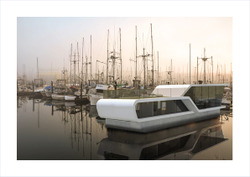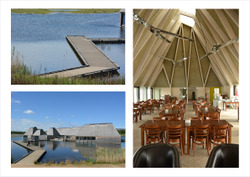07b_ As nobody had drowned by this stage, we began to test how much our 1:10 model could support by using bricks. Our design was only able to support two bricks, but with the addition of more styrofoam it was able to support five bricks comfortably, even against the vicious tide.
Posted 14 May 2014 16:43
07a_ Following the completion of our model, we took it to Sale Water Park to test. Such a dangerous environment required all the relevant PPE before entering the water- wellies, wetsuit and life jacket. The risk of drowning and hypothermia was then significantly reduced.
Posted 14 May 2014 16:31
06b_ While the main aim of our model was to represent the technology, we added a sample flooring and some walls to give an indication of structure.
Posted 14 May 2014 16:20
06a_ We then began to construct a 1:10 model. A simple timber structure held in the styrofoam base that represented the mushroom material. This was able to slide up and down metal piles that were fitted to the base.
Posted 14 May 2014 16:16
05_ Research led us to a buoyant material that we could use in our structure's foundations. Ecovative Design in the USA use agricultural waste and fungus to grow mushroom materials that are natural, renewable and biodegradable. The buoyancy has led to the material being used in the construction of surfboards and it could actually be grown on site in a matter of days.
Posted 14 May 2014 16:08
04_ We settled on a design that would be a permanent feature as opposed to a temporary structure or one that required assembly. The concept was so that it would be used as a conventional garden shed or outhouse that provided floating shelter during flooding, by simply floating using buoyant materials in its foundation and held in position by sliding up and down 'guide piles'.
Posted 14 May 2014 15:58
03_ On the second Wednesday of the events program we were given a talk by Andrew Cameron from the Environments Agency. He informed us of the extensive work they do to prevent flooding and how serious a risk it is becoming and has been in the UK. We then discussed design ideas with him and his knowledge gave us extra criteria for our design to fulfill.
Posted 14 May 2014 15:41
02b_ Due to the low land level in Netherlands, floating architecture is far more common. As such, the Dutch architect Koen Olthuis and his firm Waterstudio have produced a large number of designs from domestic housing to floating ocean-liner terminals, however very few designs have gone further than the conceptual stage.
Posted 14 May 2014 15:30
02a_ Following on from this visit, we began to research precedents on a more domestic scale that would therefore be more suited to provide temporary flood relief for a small number of people. One such precedent was the Kevell Eco Floating Home by Aquashell in France.A basic design inspired by a lobster pot that could house a family of 5.
Posted 14 May 2014 15:26
01b_ The award winning project was completed in June 2011. 'The buildings and open spaces form a village-like cluster that floats on a large pontoon' and therefore has unlimited flood protection.
www.adamkhan.co.ukPosted 14 May 2014 15:12
01a_ On the first Friday of the events program we took a trip to Brockhole Nature Reserve near Preston to see the floating visitor and education centre by Adam Khan Architects.
Posted 14 May 2014 15:08










